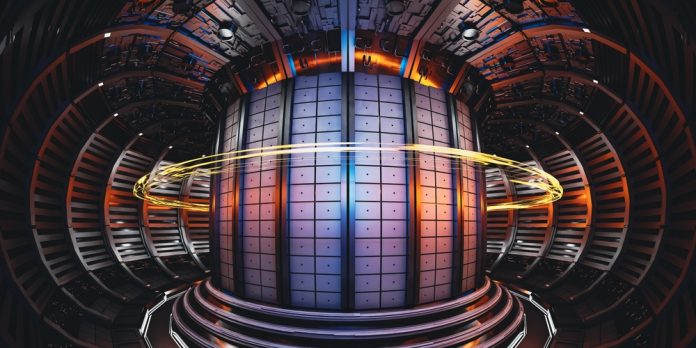The quest for clean and sustainable energy sources has taken centre stage in the 21st century. Nuclear fusion, the process that powers stars, holds immense promise in this regard.
Unlike the Sun’s readily available hydrogen fuel, replicating fusion on Earth requires specific isotopes, and tritium plays a crucial role in this endeavour.
This article delves into the world of tritium, exploring its properties, its significance in nuclear fusion, and the future outlook for this vital element.
Tritium explained: A radioactive isotope with a unique role
Tritium is a radioactive isotope of hydrogen, meaning it possesses the same single proton in its nucleus as regular hydrogen but boasts an additional neutron.
This extra neutron makes tritium unstable, causing it to decay into helium-3 while releasing a low-energy beta particle. Despite its radioactivity, tritium poses a minimal health risk due to its weak emissions and a relatively short half-life of approximately 12.3 years.
Tritium occurs naturally in minute quantities due to cosmic ray bombardment of atmospheric gases, but these quantities are far too small for any practical use in fusion reactions.
Nuclear fusion: The power of merging atoms
Nuclear fusion is the process by which the nuclei of two lighter atoms combine to form a heavier nucleus, releasing a tremendous amount of energy in the process.
This is the opposite of nuclear fission, used in today’s nuclear power plants, which splits heavy atoms. Fusion reactions require incredibly high temperatures (on the order of millions or even hundreds of millions of degrees Celsius) and pressures to overcome the natural repulsion between atomic nuclei.
These extreme conditions force the nuclei close enough for the strong nuclear force to overpower the electrostatic repulsion and initiate fusion. There are various types of fusion reactions, each involving the fusion of different isotopes. The most promising for near-term applications utilises a mixture of two hydrogen isotopes: deuterium and tritium (D-T reaction).
Deuterium, another isotope of hydrogen with one neutron, is readily available in seawater, as it constitutes about 0.015% of all hydrogen in water. However, tritium, with its extra neutron, is a much rarer isotope.
Why tritium is favoured for fusion reactions
The D-T reaction is favoured for several reasons. It requires a lower temperature (around 100 million degrees Celsius) compared to other fusion reactions, such as deuterium-deuterium (D-D) fusion, which necessitates temperatures exceeding 300 million degrees Celsius.
This lower temperature threshold makes D-T fusion more achievable with current magnetic confinement technology used to confine the superheated plasma within fusion reactors.
When deuterium and tritium fuse, they release a helium-4 nucleus, a neutron, and a significant amount of energy. This energy release is substantial, with a single D-T reaction producing roughly 17.6 MeV (Megaelectronvolts) of energy, which is about 15 times the energy released during the burning of a single molecule of fossil fuel.
The released neutrons carry most of the energy and can be used to heat a surrounding lithium blanket. This blanket serves two key purposes. First, the high-energy neutrons collide with lithium-6 atoms within the blanket, converting them into tritium through a breeding process, and second, the heated blanket transfers its thermal energy to a heat exchanger, ultimately generating electricity through a conventional steam turbine system similar to those used in fossil fuel power plants.
Challenges of using tritium
Despite its advantages, tritium presents a challenge for fusion development. It’s rarely found in nature and needs to be produced artificially. Currently, tritium is extracted from fission reactors as a by-product of the neutron bombardment of lithium-6.
However, the global supply of tritium is limited, and future fusion reactors are expected to require much larger quantities of tritium to operate continuously. Estimates suggest a commercial fusion reactor could burn through hundreds of kilograms of tritium per year.
To address this challenge, researchers are exploring tritium breeding within the fusion reactor itself. This process involves placing a ‘breeding blanket’ made of lithium around the reactor core. The neutrons released during the D-T reaction can interact with lithium-6 in the blanket, converting it into tritium.
In this reaction, a neutron (n) collides with a lithium-6 (⁶Li) nucleus, resulting in the release of an alpha particle (α) and a tritium atom (³H). This breeding process offers a path towards self-sufficiency, where the fusion reactor itself produces the tritium it needs to sustain the reaction.
Environmental benefits compared to traditional fission
Nuclear fusion offers a significant environmental advantage over traditional nuclear fission. Fusion reactions do not produce long-lived radioactive waste, a major concern associated with fission power plants.
Additionally, the risk of meltdowns or uncontrolled chain reactions, like those that occurred at Chornobyl and Fukushima, is absent in fusion reactors. While tritium is radioactive, its short half-life and the possibility of closed-loop recycling within the reactor itself minimise the potential for environmental contamination.
Safety considerations of handling tritium
Tritium, like any radioactive material, requires careful handling and storage. Due to its low-energy beta emissions, tritium poses a minimal external radiation hazard.
However, the primary concern is inhalation or ingestion, as tritium can be incorporated into water molecules and taken up by the body. Therefore, fusion facilities need robust safety protocols and containment measures to prevent tritium leaks and ensure worker and environmental safety.
A stepping stone to a brighter energy future
Tritium plays a pivotal role in the development of nuclear fusion as a clean and sustainable energy source.
While challenges remain in terms of tritium breeding and potential alternatives, ongoing research offers promising solutions. Overcoming these hurdles and achieving a sustained fusion reaction will usher in a new era of abundant, clean energy, paving the way for a more secure and sustainable future for our planet.









